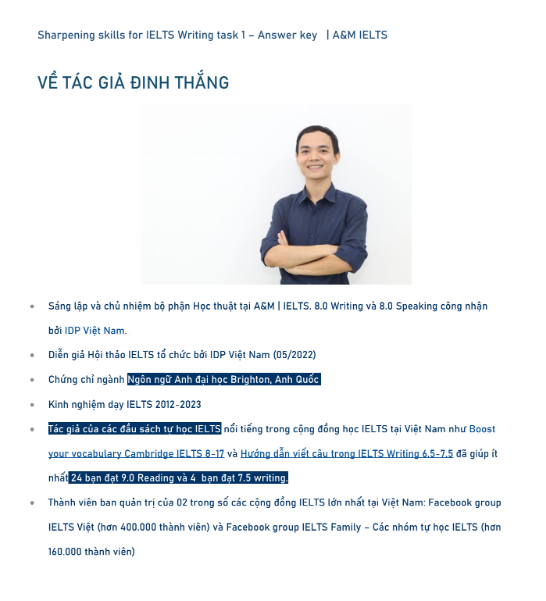


Mục lục
ToggleContents
1. Line Chart ………………………………………………………………………………………………………….. 7
1.2. Simon – Internet Users as percentage of population …………………………………………………….. 7
1.3. Simon – International migration in UK ………………………………………………………………………… 7
1.4. Simon – UK acid rain emission ……………………………………………………………………………………. 8
1.5. Simon – Water consumption ……………………………………………………………………………………… 9
1.6. Simon – Car ownership ……………………………………………………………………………………………… 9
1.7. Public Transport Usage ……………………………………………………………………………………………. 10
1.8. Global Tourism ……………………………………………………………………………………………………….. 10
1.9. Fuel Expenditure ……………………………………………………………………………………………………… 11
1.10. Urban Crime Trends ………………………………………………………………………………………………. 11
1.11. Canadian Graduates ……………………………………………………………………………………………….. 12
1.12. Whooping Cough Vaccinations ………………………………………………………………………………… 12
1.13. Rural-Urban Migration ……………………………………………………………………………………………. 13
1.14. Capital City Migration ……………………………………………………………………………………………… 13
1.15. Recycled Materials (Road to IELTS Test 3) ……………………………………………………………….. 14
1.16. Bakery Sales (Road to IELTS Test 4) …………………………………………………………………………. 14
2. Bar Chart …………………………………………………………………………………………………………… 16
2.2. Simon – Marriages and Divorces ……………………………………………………………………………….. 16
2.3. Simon – Levels of Participation ………………………………………………………………………………….. 16
2.4. Simon – Consumer Goods …………………………………………………………………………………………. 17
2.5. Simon – House Prices ………………………………………………………………………………………………… 17
2.6. News Consumption ………………………………………………………………………………………………….. 18
2.7. Global Urbanization …………………………………………………………………………………………………. 19
2.8. Brazilian Weather …………………………………………………………………………………………………….. 19
2.9. Charitable Giving …………………………………………………………………………………………………….. 20
2.10. Southland Exports …………………………………………………………………………………………………. 20
2.11. International Graduates in Canada …………………………………………………………………………… 21
2.12. Global Ageing …………………………………………………………………………………………………………. 21
2.13. Industry Share ………………………………………………………………………………………………………… 22
2.14. UK Workforce …………………………………………………………………………………………………………. 22
2.15. UK Housing ……………………………………………………………………………………………………………. 23
2.16. Gender Employment ……………………………………………………………………………………………….. 23
2.17. Computer Ownership ……………………………………………………………………………………………… 23
2.18. Household Spending ……………………………………………………………………………………………….. 24
3. Table …………………………………………………………………………………………………………………… 24
3.1. Simon – Rail Networks ……………………………………………………………………………………………… 24
3.2. Simon – Poverty Proportion in Australia ……………………………………………………………………… 24
3.4. Simon – Daily Activities ……………………………………………………………………………………………… 25
3.5. Simon – Goods Consumption …………………………………………………………………………………….. 25
3.6. Patient Satisfaction …………………………………………………………………………………………………… 26
3.7. Bristol University Enrolment ………………………………………………………………………………………. 26
3.8. Production of Grains …………………………………………………………………………………………………. 27
4. Pie Chart …………………………………………………………………………………………………………….. 28
4.1. Tips for Pie Chart ……………………………………………………………………………………………………… 28
4.2. Electricity Production Sources ……………………………………………………………………………………. 28
4.3. Simon – Diet ……………………………………………………………………………………………………………… 28
4.4. Student Expenditure …………………………………………………………………………………………………. 28
4.5. Online Shopping Trends ……………………………………………………………………………………………. 29
4.6. TV Viewing Devices ………………………………………………………………………………………………….. 29
4.7. News Access …………………………………………………………………………………………………………….. 30
5. Map ……………………………………………………………………………………………………………………… 31
5.1. Tips for Map …………………………………………………………………………………………………………….. 31
5.2. Simon – Village of Chorleywood …………………………………………………………………………………. 31
5.3. Simon – Gallery …………………………………………………………………………………………………………. 31
5.4. Simon – House Design ……………………………………………………………………………………………….. 31
5.5. Simon – Two Proposed Supermarkets ………………………………………………………………………….. 32
5.6. Museum Floor Plans …………………………………………………………………………………………………. 32
5.7. West Park School Evolution ……………………………………………………………………………………….. 33
5.8. Fossil Discovery ………………………………………………………………………………………………………… 33
5.9. Headland Erosion ……………………………………………………………………………………………………… 34
5.10. Stokeford Village Evolution ………………………………………………………………………………………. 34
5.11. Museum Transformation …………………………………………………………………………………………. 35
5.12. Poulton Town Evolution …………………………………………………………………………………………… 35
5.13. Fosbury Town Expansion …………………………………………………………………………………………. 36
5.14. Dubai Transformation ………………………………………………………………………………………………. 36
5.15. University Campus Upgrades …………………………………………………………………………………… 37
6. Process ………………………………………………………………………………………………………………… 38
6.1. Tips for Process Diagram …………………………………………………………………………………………… 38
6.2. Simon – Forecast in Australia ……………………………………………………………………………………… 38
6.3. Simon – Brick Manufacturing ………………………………………………………………………………………. 38
6.4. Simon – Water Cycle …………………………………………………………………………………………………. 39
6.5. Simon – Paper Recycling ……………………………………………………………………………………………. 39
6.6. Honey Production …………………………………………………………………………………………………….. 40
6.7. Fish Pie Production …………………………………………………………………………………………………… 40
6.8. Forestry Management ……………………………………………………………………………………………….. 41
6.9. Plastic Bottle Recycling ……………………………………………………………………………………………… 41
6.10. Wood Production ……………………………………………………………………………………………………. 42
6.11. Clog Making ……………………………………………………………………………………………………………. 42
6.12. Lithography Printing ………………………………………………………………………………………………… 43
6.13. Tepee Construction …………………………………………………………………………………………………. 43
7. Mixed Charts …………………………………………………………………………………………………………. 44
7.1. Weather Patterns ……………………………………………………………………………………………………… 44
7.2. Population Figures in Japan ……………………………………………………………………………………….. 44
7.3. Healthcare Resources and Life Expectancy …………………………………………………………………. 45
7.4. Endangered Plants …………………………………………………………………………………………………….. 45
7.5. Biodiversity Threats …………………………………………………………………………………………………… 46
7.6. Education and Employment ……………………………………………………………………………………….. 46
7.7. 3D Cinema ………………………………………………………………………………………………………………… 47
7.8. Olympic Participants …………………………………………………………………………………………………. 48
7.9. Entertainment Venues – Road to IELTS Test 2 ………………………………………………………………. 48
1. LINE CHART
1.1. Tips for “Line Chart”
1.2. Simon – Internet Users as Percentage of Population
- Phần trăm người Việt Nam và Thái Lan đọc sách hàng ngày là lớn hơn khi so sánh với người Lào.
Gợi ý: A much larger percentage, in comparison with
Answer: A much larger percentage of Vietnamese and Thais read books daily in comparison with Laotians. - Việt Nam đã trải qua sự tăng trưởng nhanh nhất về số người đọc sách hàng ngày.
Gợi ý: experienced the fastest growth
Answer: Vietnam experienced the fastest growth in the number of people reading books daily. - Số liệu của Việt Nam và Lào thấp hơn, ở mức lần lượt là 20% và 40%.
Gợi ý: The figures, respectively
Answer: The figures for Vietnam and Laos were lower, at 20% and 40%, respectively. - Vào năm 2010, số lượng người đọc sách tại Việt Nam đã tăng lên 2 triệu người, trong khi số liệu của Lào đạt 1,2 triệu người.
Gợi ý: rose, while
Answer: In 2010, the number of people reading books in Vietnam rose to 2 million, while the figure for Laos reached 1.2 million. - 35% người Việt Nam đã đọc sách, so sánh với 30% của Lào và 25% của Campuchia.
Gợi ý: compared to
Answer: 35% of Vietnamese read books, compared to 30% of Laotians and 25% of Cambodians.
1.3. Simon – International Migration in UK
- Số lượng người đi xem phim và đọc sách đều tăng trong suốt khoảng thời gian đã cho, nhưng số liệu của người xem phim cao hơn đáng kể.
Gợi ý: significantly higher
Answer: The number of people going to the movies and reading books both increased over the given period, but the figures for moviegoers were significantly higher. - Số lượng người đi xem phim đã đạt đỉnh vào năm 2010 và 2015.
Gợi ý: peaked
Answer: The number of people going to the movies peaked in 2010 and 2015. - Vào năm 2000, có 2 triệu người đọc sách trong khi số lượng đi xem phim đứng ở mức 3 triệu người.
Gợi ý: stood at
Answer: In 2000, there were 2 million people reading books while the number of moviegoers stood at 3 million. - Số liệu cho người đọc sách là 2 triệu người vào năm 2000, và số liệu này vẫn giữ nguyên mức đó cho đến năm 2005.
Gợi ý: remained at a similar level
Answer: The figure for book readers was 2 million in 2000, and it remained at a similar level until 2005. - Từ 2010 đến 2015, số lượng người đọc sách tăng đến 3 triệu người, nhưng có một sự tăng lên ít hơn rất nhiều ở số lượng người đi xem phim.
Gợi ý: a much smaller rise
Answer: From 2010 to 2015, the number of book readers increased to 3 million, but there was a much smaller rise in the number of moviegoers. - Sau năm 2010, số lượng người xem phim vẫn duy trì ở mức cao, nhưng số lượng người đọc sách dao động.
Gợi ý: remain high, fluctuated
Answer: After 2010, the number of moviegoers remained high, but the number of book readers fluctuated. - Số lượng người đọc sách giảm đột ngột vào năm 2017 trước khi đạt đỉnh vào năm 2019.
Gợi ý: fell suddenly, peak (v) at
Answer: The number of book readers fell suddenly in 2017 before peaking in 2019. - Số lượng người đi công viên tăng lên 2.5 triệu người vào năm 2015, nhưng lại về mốc 1.2 triệu người vào năm 2017.
Gợi ý: fell back to
Answer: The number of park visitors increased to 2.5 million in 2015, but fell back to 1.2 million in 2017.
1.4. Simon – UK Acid Rain Emission
- Sự suy giảm gia tăng mạnh nhất được thấy ở lượng mì gói được tiêu thụ.
Gợi ý: the most dramatic decrease
Answer: The most dramatic decrease was seen in the amount of instant noodles consumed. - Việt Nam đã chịu trách nhiệm cho 6 tấn khí thải CO₂, trong khi Thái Lan đã thải ra 7,2 tấn.
Gợi ý: be responsible for
Answer: Vietnam was responsible for 6 tons of CO₂ emissions, while Thailand emitted 7.2 tons. - Trong khi lượng mì gói giảm dần dần, lượng muối được tiêu thụ đã chứng kiến một sự tăng nhẹ vào năm 2010, đạt đỉnh 3 tấn vào năm 2012.
Gợi ý: While, reaching a peak of
Answer: While the amount of instant noodles gradually decreased, the amount of salt consumed saw a slight increase in 2010, reaching a peak of 3 tons in 2012.
1.5. Simon – Water Consumption
- Rõ ràng là tỉ lệ tội phạm ở Châu Á tăng đáng kể từ năm 2000 đến 2010, và Thái Lan chiếm phần lớn nhất trong số đó.
Gợi ý: rose significantly, accounted for, the largest proportion
Answer: It is clear that the crime rate in Asia rose significantly from 2000 to 2010, and Thailand accounted for the largest proportion of it. - Cho đến năm 2010, số lượng tội phạm ở Việt Nam đã tăng đến 2 triệu, Thái Lan tăng lên 2.1 triệu và Lào đã đạt 2.3 triệu.
Gợi ý: By (year), had + PII
Answer: By 2010, the number of crimes in Vietnam had increased to 2 million, Thailand had risen to 2.1 million, and Laos had reached 2.3 million. - Vào năm 2010, dân số của nước A và B lần lượt là 5 triệu và 10 triệu.
Gợi ý: respectively
Answer: In 2010, the populations of country A and B were 5 million and 10 million, respectively. - Số lượng thóc của nước A, ở mức 2 tấn, cao hơn nhiều so với nước B, ở mức 0.6 tấn, điều này có thể được giải thích bởi sự thật là nước A có gấp 20 lần đất canh tác.
Gợi ý: had … times more …
Answer: The amount of rice in country A, at 2 tons, was much higher than that of country B, at 0.6 tons, which can be explained by the fact that country A had 20 times more arable land.
1.6. Simon – Car Ownership
- Nhìn chung, số lượng người Việt Nam sở hữu xe máy tăng trong khoảng 1999–2010. Cụ thể, số lượng người sở hữu xe trên 50 triệu tăng trong khi số lượng người sở hữu xe dưới 50 triệu giảm.
Gợi ý: Overall, In particular
Answer: Overall, the number of Vietnamese people owning motorbikes increased between 1999 and 2010. In particular, the number of people owning bikes worth over 50 million increased, while the number of people owning bikes worth under 50 million decreased. - Việc sở hữu xe dưới 50 triệu là rất ít phổ biến tại Việt Nam, với chỉ 5% dân số rơi vào loại này.
Gợi ý: It was uncommon for…, falling into this category
Answer: It was uncommon for people in Vietnam to own bikes worth under 50 million, with only 5% of the population falling into this category. - Xe trên 50 triệu là loại xe máy phổ biến nhất ở Việt Nam từ 1999–2010, mặc dù có một sự thay đổi nhỏ về số liệu của loại xe này.
Gợi ý: the most common type, little change
Answer: Bikes worth over 50 million were the most common type of motorbike in Vietnam from 1999 to 2010, although there was little change in their figures. - Sự thay đổi lớn nhất được nhìn thấy ở số liệu cho xe dưới 20 triệu, loại mà đã giảm đều trong suốt thời kỳ 12 năm còn 0.8 triệu người sử dụng vào năm 2010. Trái lại, số lượng người dùng xe trên 50 triệu tăng đều, đạt 30 triệu người vào năm 2010, và số liệu cho xe trên 70 triệu cũng tăng thêm 3 triệu người.
Gợi ý: little change
Answer: The most significant change was seen in the figures for bikes worth under 20 million, which steadily decreased over the 12-year period to 0.8 million users in 2010. In contrast, the number of people using bikes worth over 50 million steadily increased, reaching 30 million in 2010, and the figures for bikes worth over 70 million also rose by 3 million.
1.7. Public Transport Usage
- Sự chênh lệch giữa hai nhóm người là cực kỳ đáng chú ý ở người ăn chay và người ăn cá, với sự khác biệt lớn nhất giữa 20% người trẻ ăn chay và 62% người già ăn cá.
Gợi ý: fluctuation, pattern
Answer: The fluctuation between the two groups is extremely noticeable among vegetarians and fish eaters, with the most significant difference being between 20% of young people who are vegetarians and 62% of old people who eat fish. - Thực sự có một phần trăm thấp hơn của người già ăn chay (37%) so với người trẻ ăn chay (63%).
Gợi ý: actually, a lower percentage of
Answer: There is actually a lower percentage of old people who are vegetarians (37%) compared to younger people (63%). - Đáng lưu tâm là có một sự dao động đáng kể về thói quen ăn uống của người Việt: bắt đầu với 20% cho người ăn chay, số liệu tăng lên 30% trước khi giảm mạnh xuống đáy 12%.
Gợi ý: noteworthy, marked fluctuations, starting at, a low of
Answer: It is noteworthy that there are marked fluctuations in the eating habits of Vietnamese people: starting at 20% for vegetarians, the figure increased to 30% before dropping sharply to a low of 12%. - Trái lại, những số liệu cho người già giữ ở mức khá ổn định, với mốc cao nhất là 70% cho người ăn chay và mốc thấp nhất là 15% cho người ăn thịt lợn.
Gợi ý: By contrast, hold fairly steady, a high of, a low of
Answer: By contrast, the figures for old people hold fairly steady, with a high of 70% for vegetarians and a low of 15% for pork eaters.
1.8. Global Tourism
- Vào năm 2000, có 1000 người đi đến thư viện, gấp đôi số lượng người đi đến địa điểm được yêu thích kế tiếp, bảo tàng. Tuy nhiên, từ năm 2005 đến 2010, có một sự giảm đi 200 người trong số lượng người đi đến thư viện trong khi có một sự tăng lên 300 người đi đến bảo tàng.
Gợi ý: twice as many as, However, whereas
Answer: In 2000, 1000 people went to the library, twice as many as those who went to the next most popular place, the museum. However, from 2005 to 2010, there was a decrease of 200 people going to the library whereas there was an increase of 300 people going to the museum. - Vào năm 2005, số lượng người đi đến thư viện và bảo tàng gần như bằng nhau, ở mốc 700 người.
Gợi ý: almost equal
Answer: In 2005, the number of people going to the library and the museum was almost equal, at 700. - Số lượng người đi đến công viên tăng một cách ổn định trong suốt thời kỳ, nhưng cho đến năm 2012, tổng số người chỉ có 220 người.
Gợi ý: rose steadily, the total was still
Answer: The number of people going to the park rose steadily throughout the period, but by 2012, the total was still only 220 people. - Số lượng người đi đến rạp chiếu phim và công viên vẫn tương đồng từ năm 2000 đến năm 2005, nhưng sau đó có một sự tăng lên lớn hơn ở số lượng người đi đến công viên so với rạp chiếu phim.
Gợi ý: similar, a greater increase
Answer: The number of people going to the cinema and the park was similar from 2000 to 2005, but thereafter there was a greater increase in the number of people going to the park compared to the cinema.



